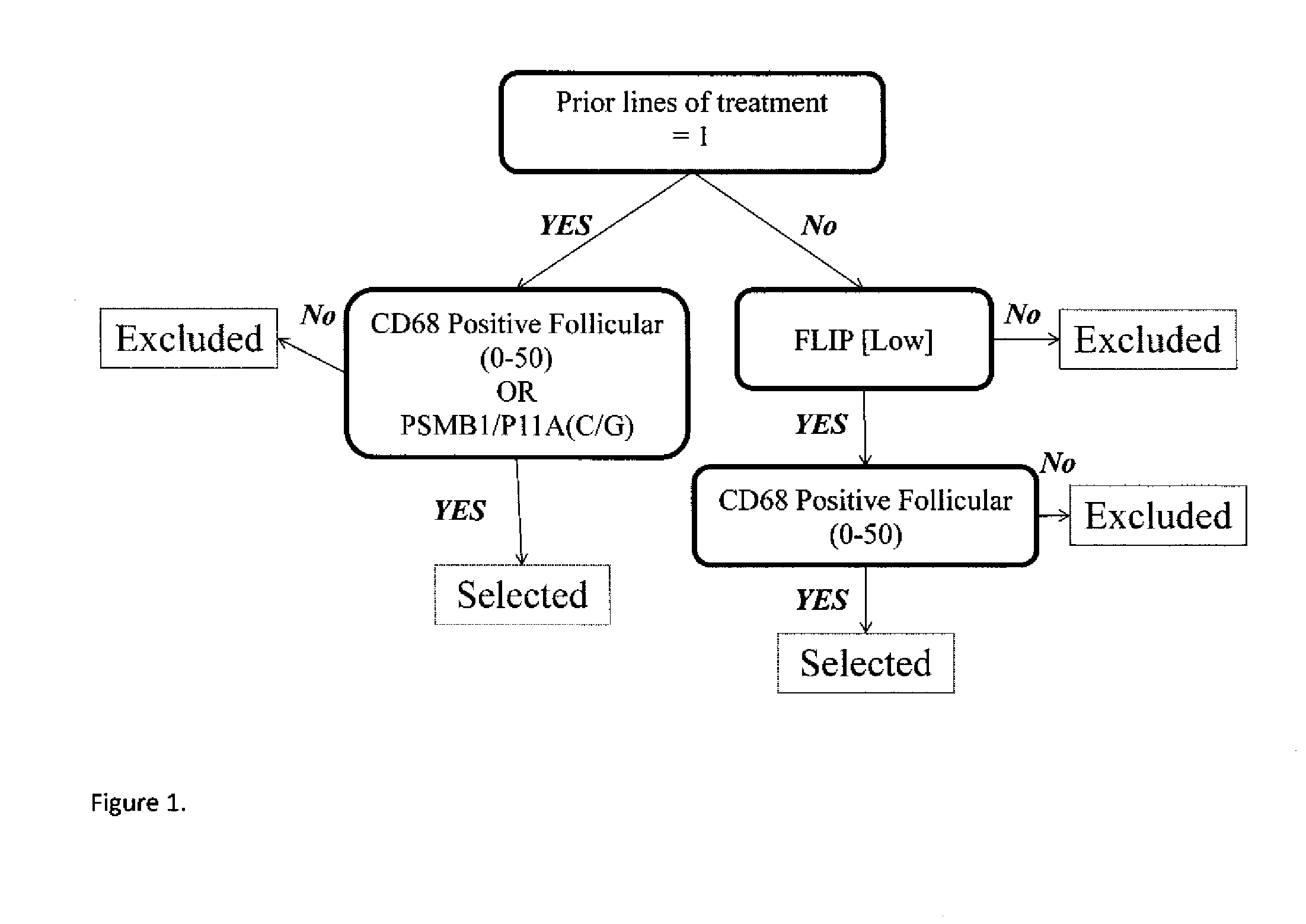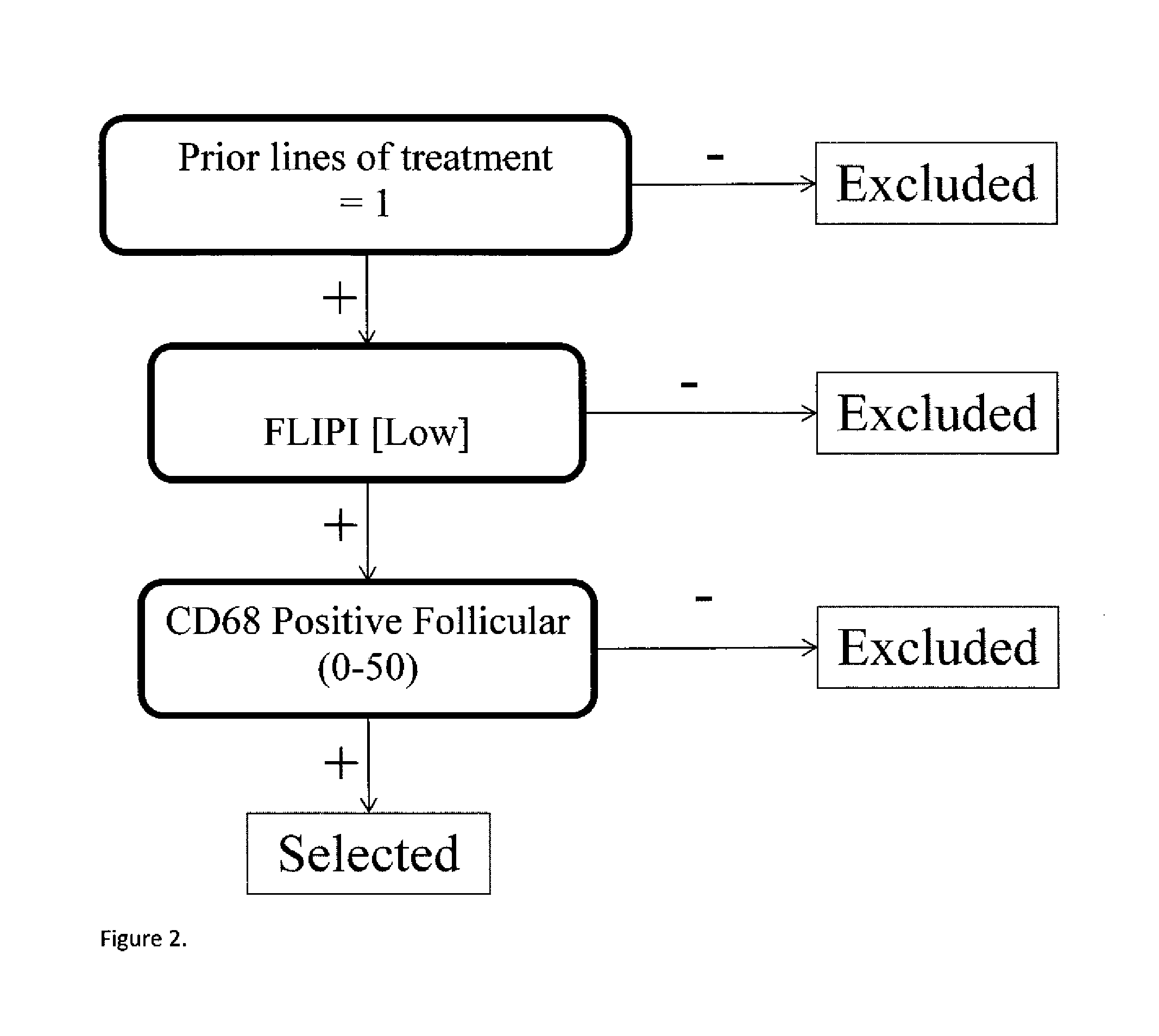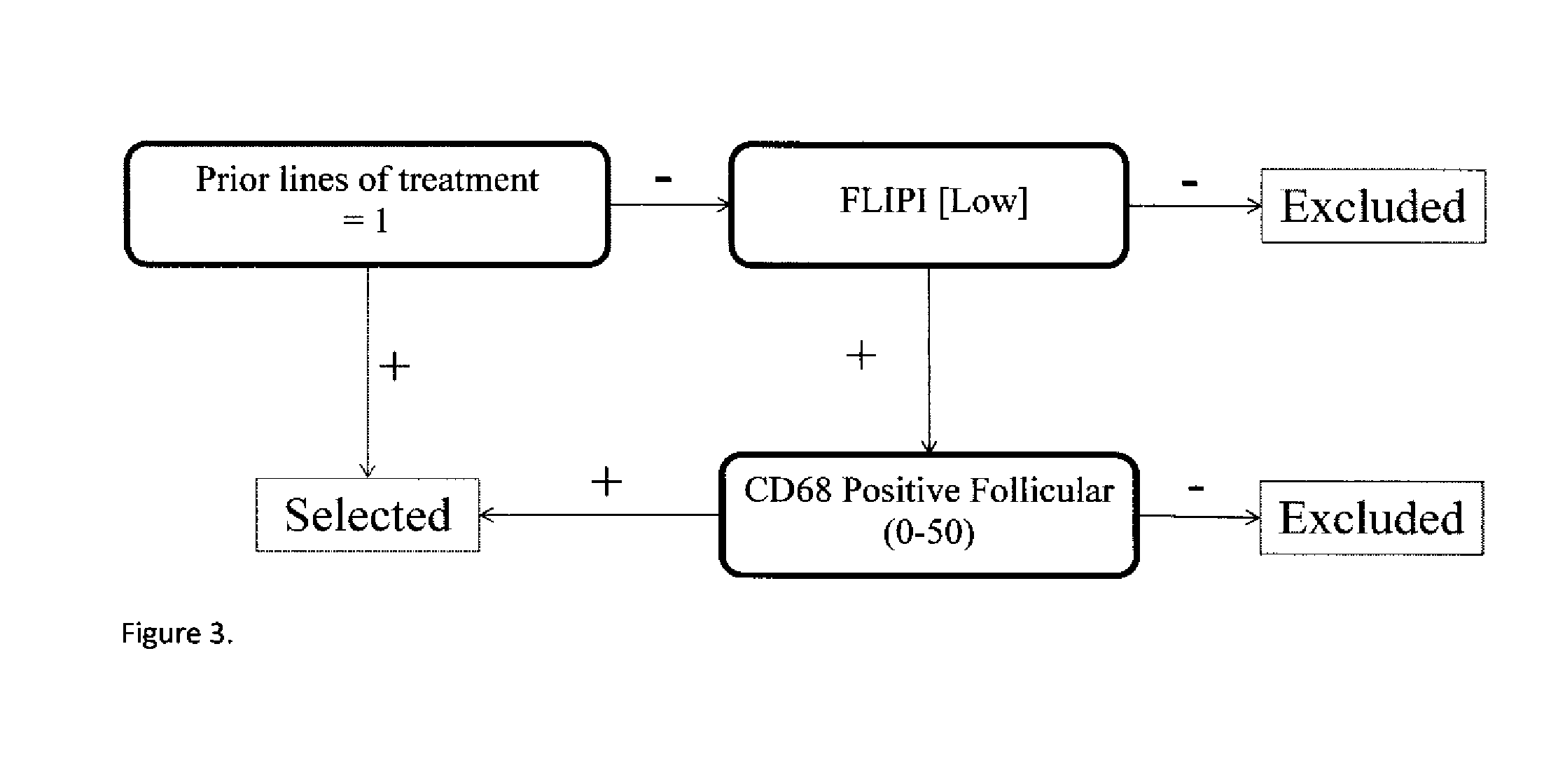Predictors for Cancer Treatment
a cancer patient and drug sensitivity technology, applied in the field of cancer patients' prediction, can solve the problems of difficult to predict drug sensitivity in patients, ineffective and even and potentially harmful treatment regimens for patients with different responses, and achieve the effect of low tumor burden and low flipi scor
- Summary
- Abstract
- Description
- Claims
- Application Information
AI Technical Summary
Benefits of technology
Problems solved by technology
Method used
Image
Examples
example 1
[0037]Non-Hodgkin lymphoma (NHL) encompasses several unique malignant lymphoid disease entities that vary in clinical behavior, morphologic appearance, immunologic, and molecular phenotype. Follicular lymphoma (FL), the most common indolent NHL, exhibits similar variability with some patients exhibiting very slow disease course while others progress and die within only 5 year (Dave 2004). A randomized, open-label, active-controlled, multicenter, multinational, prospective study to compare the efficacy and safety of the combination of bortezomib and rituximab (Vc-R) to single-agent rituximab in subjects who have relapsed or refractory, rituximab-naive or -sensitive follicular B-cell NHL was performed.
[0038]Subjects were centrally randomized to Treatment Groups A (Vc-R) or B (rituximab) in a 1:1 ratio taking into account the following stratification factors:[0039]Follicular Lymphoma International Prognostic Index (FLIPI) score (low [0 or 1 factor], intermediate [2 factors], high [≧3 f...
example 2
[0104]Single predictors which correlated with a positive response are shown in Table 5.
TABLE 5Single predictors.PFSMarkerVc + R vs. RNLogrank% N inMarker ASubtypemedian daysVc + R vs. RP-valueITTCD68 OVERALL 0-2511.5 mo vs 10.6 mo40 vs 440.42212.4POSITIVE0.9 mo PFS improvementCD68 OVERALL26-5012.1 mo vs 9.3 mo114 vs 1080.058832.9POSITIVE2.8 mo PFS improvementCD68 POSITIVE 0-2514.1 mo vs 9.3 mo50 vs 600.093416.3FOLLICULAR4.8 mo PFS improvementCD68 POSITIVE26-5013.4 mo vs 9.1 mo84 vs 910.028925.9FOLLICULAR4.3 mo PFS improvementP65 INTENSITY11.6 mo vs 9.3 mo41 vs 430.245512.4CYTOPLASMIC2.3 mo PFS improvementSIGNALPSMB1 / P11AC / G14 mo vs 9.3 mo115 vs 1270.021835.94.7 mo improvementPSMB5 / R24CC / T17.6 mo vs 9.3 mo41 vs 410.401612.18.3 mo improvement
example 3
[0105]Predictor pairs which correlated with a positive response are shown in Tables 6 and 7.
TABLE 6Significant marker pairs.PFSVc − R vs. RNLogrankMarker AMarker Bmedian monthVc − R vs. RP-valueFDRPSMB5 / R24CP65 INTENSITY27 mo vs. 10.4 mo5 vs. 70.04390.489C / TCYTOPLASMIC SIG-16.6 mo improvementNAL PSMB1 / P11A20S % POSITIVE18.9 mo vs. 9.5 mo50 vs 500.01450.447C / GCYTOPLASMIC SIG-9.4 improvementNAL: >90PSMB1 / P11ACD68 POSITIVE16.6 mo vs. 9.1 mo57 vs 610.00010.051C / GFOLLICULAR: 0-507.5 mo improvementPSMB1 / P11ACD68 POSITIVE16.6 mo vs. 9.2 mo24 vs 280.03650.471C / GPERIFOLLICULAR: >507.4 improvementPSMB9 / R60HP65 % NUCLEAR16.2 mo vs. 9.5 mo35 vs 280.03030.455G / GSTAINING: >06.7 improvementPSMB5 / R24CCD68 POSITIVE13.7 mo vs. 7.2 mo18 vs 210.02200.447C / TFOLLICULAR: 0-506.5 mo improvementHI Tumor BDCD68 OVERALL22.8 mo vs. 16 mo64 vs 680.01770.447NOPOSITIVE: 0-506.8 mo improvementHI Tumor BDCD68 POSITIVE20.5 mo vs. 13.8 mo64 vs 660.03100.455NOFOLLICULAR: 0-506.7 mo improvementPrior RX: 1CD68 POSITIVE1...
PUM
 Login to View More
Login to View More Abstract
Description
Claims
Application Information
 Login to View More
Login to View More - R&D
- Intellectual Property
- Life Sciences
- Materials
- Tech Scout
- Unparalleled Data Quality
- Higher Quality Content
- 60% Fewer Hallucinations
Browse by: Latest US Patents, China's latest patents, Technical Efficacy Thesaurus, Application Domain, Technology Topic, Popular Technical Reports.
© 2025 PatSnap. All rights reserved.Legal|Privacy policy|Modern Slavery Act Transparency Statement|Sitemap|About US| Contact US: help@patsnap.com



